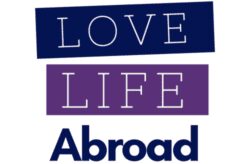Are you planning a trip to Southern Utah and wondering which is the best national park in Utah for kids?
It’s a hard one. Each of the Utah National Parks with kids will be a lot of fun and in the end, it comes down to your personal preference.
So today, we are sharing with you all the fun things to do in Utah’s Mighty 5 with kids, so you can decide which one is the best national park in Utah for kids and which one you should visit.
Disclaimer: Just a heads up, this free article contains affiliate links. If you purchase after clicking one of these links, I may earn a small commission at no additional cost. Also, as an Amazon Associate, I earn from qualifying purchases. Your support helps me continue to provide helpful and free content for you.
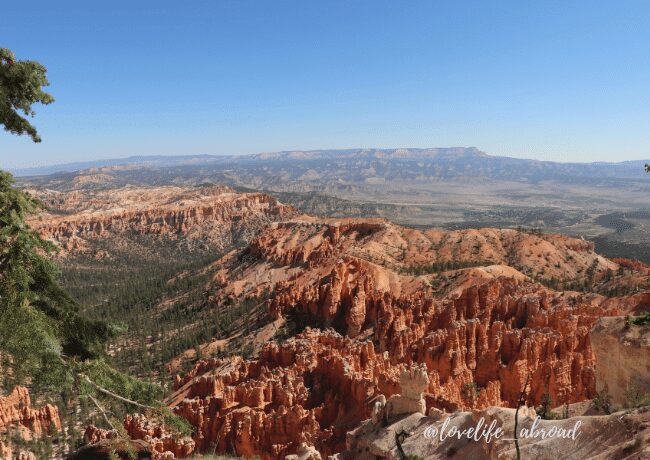
Why You Should Vist the Utah National Parks With Your Kids
Utah blew us away. Before our visit, we had a vague idea of what to expect after seeing a few epic images on social media. Well, it wasn’t a disappointment. Utah has such a unique landscape.
Red Rocks. Hoodoos. Amazing hikes. Natural hot springs. Mountain peaks.
The only problem you’ll be facing when planning your trip to Utah is not having enough time to see it all. So let’s concentrate on the Utah National Park’s with for this post.
Utah National Parks Road Trip: An Overview of “The Mighty 5”
Utah is home to 5 of the 63 US National Parks. Only Alaska and California have more national parks on their territory than Utah. In addition to the 5 national parks, there are 8 other national park units in Utah such as:
- Grand Escalante Staircase National Monument,
- Glen Canyon National Recreation Area (including Lake Powell),
- Dinosaurs National Monument and
- a few others.
You might have heard the term “The Mighty 5” when it comes to the 5 national parks in Utah. The Mighty 5 is a term used to include all 5 Utah National Parks: Zion, Bryce Canyon, Capitol Reef, Arches and Canyonland.
The 5 parks are collectively known for their distinct red sandstone rock formations, their red-rock canyons and multiple stunning viewpoints. But let’s take a look at each of them individually.
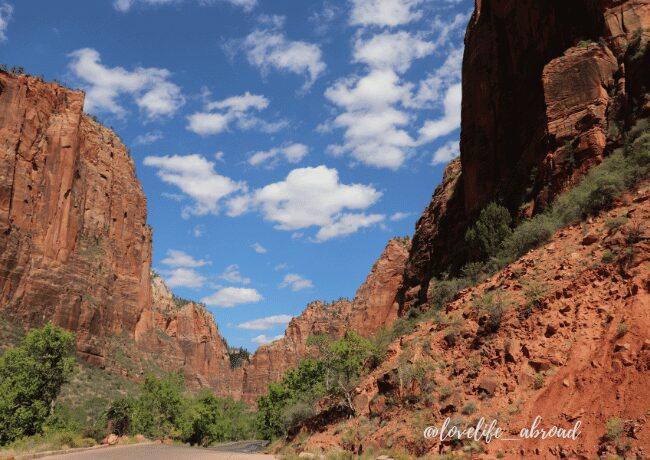
Zion National Park With Kids
Zion National Park is the most popular and visited of the Mighty 5, with more than 3.5 million visitors per year. It is famous for its narrow and deep canyons. Zion National Park is the closest one to Las Vegas.
Fun Facts About Zion National Park
- Elevation: 3,000 feet
- Surface: 232 square miles
- Highest point: 8,726 feet at Horse Ranch Mountain summit
- Visitor: 3.5+ million per year
- Closest town: Springdale
Download our 10-Day Utah National Parks Road Trip Itinerary
Zion is by far the most crowded of all 5 Utah National Parks and it’s important to know that the park’s shuttle is mandatory along the scenic road (where most sights and hikes are). It’s not possible to drive your own car.
There might be some wait time to get on the bus, so plan your Zion National Park itinerary accordingly. The section leading to the Zion-Mount Carmel Tunnel is accessible by car, and there are a few vista points along the way.
Best Family Hikes in Zion National Park
Zion National Park is famously known for two great hikes:
- the Angel Landing (2.5 miles long with 1,500 feet gain in elevation) and
- The Narrows (a 10 miles round-trip through the Virgin River).
While those hikes are amazing hikes, they may not be the best for children, depending on their age.
Lower Emerald Pool Trail
The Lower Emerald Pool trail is a great choice for a family hike. It’s a 1.4 miles, out-and-back easy hike that leads to a waterfall. At the waterfall, it’s possible to continue to the Middle and Upper pools.
Riverside Walk
The Riverside Walk at the Temple of Sinawava, a 2-mile long accessible trail, is also a good option for kids. It leads to the entrance of The Narrows trail.
Where to Stay When Visiting Zion National Park
The town of Springdale has lots of different options for lodging. It also has a shuttle that runs all day to get into the national park.
There is everything needed in the town (restaurants, shops, grocery stores). Be warned, food is overpriced. If you plan on cooking, maybe try to do your grocery shopping before arriving in the Zion national park area.
We stayed at Zion Canyon Campground and RV Resort just outside the park entrance and it was great. It’s not the cheapest campground, but the views are amazing. Plus, it’s a family-friendly campground with a pool and a playground.
The Zion National Park Shuttle stops by the campground, but before it’s one of the last stops, it can be hard to have a place on it. We had to walk to the entrance of the park because a few full buses passed by us.

Bryce Canyon National Park With Kids
Bryce Canyon National Park is the highest altitude of all the Mighty 5, with an average elevation of 8,000-9,000 feet. It is popular for its particular landscape covered in hoodoos and showcasing its amphitheatres.
Fun Facts About Bryce Canyon National Park
- Elevation: 8,000 to 9,000 feet
- Surface: 56 square miles
- Highest point: 9,100 feet at Rainbow Point
- Visitor: 2.5+ million per year
- Closest town: Bryce Canyon City
Download our 10-Day Utah National Parks Road Trip Itinerary
Bryce Canyon National Park is best visited on the park’s shuttle bus. It runs every 10-20 minutes with stops around the rim of the amphitheatres. Parking space is limited at each viewpoint, so it is worth taking the shuttle. Plus, it’s a fun activity for the kids.
The best way to explore the park with kids is to take the shuttle up to the furthest bus stop, Bryce Point, and then return to the visitor center stopping at Inspiration Point, Sunset Point, Bryce Lodge, and Sunrise Point. Each stop offers breathtaking viewpoints.
The park has two entrances: the main entrance with the park’s shuttle and the Mossy Cave trail entrance.
Bryce Canyon Hikes for Familie
As for hiking with kids, Bryce National Park isn’t the safest for little ones. There are some safety railings at the viewpoints, but they are not present along the trails. For example, with 2.5 and 4.5-year-old independent boys, we didn’t walk the rim trail from Sunset Point to Sunrise Point. The trail is along the rim and there is no guarding at all, it didn’t seem safe with two walking toddlers. Use your best judgment.
Mossy Cave Trail
If you plan to head over to Capitol Reef using Byway 12, a stop at Mossy Cave trail is a must. The Mossy Cave trail is a 0.8 miles out-and-back trail with a cave and a waterfall. It’s also possible to hide behind the waterfall and cool off.
Navajo Loop Trail & Queens Garden Trail
The Navajo Loop trail (1.5 miles loop) and the Queens Garden Trail (1.8 miles out-and-back trail) are good options for family hikes.
Where to Stay When Visiting Bryce Canyon National Park
There is one campground in Bryce Canyon National Park with a shuttle bus stop, the Sunset Campground. But as with all national parks campgrounds, they filled up super quickly.
Bryce Canyon City is the best place to stay for exploring Bryce National Park. There are a few different options for lodging on the resort, from campsites to luxury rooms. And you’ll need everything in the city: a general store, restaurants, an ice cream shop, guided tours and so much more. Plus, the Bryce Canyon National Park shuttle stops at several locations around town.
We stayed at the Bryce View Lodge, part of the Ruby’s Inn Resort. We had a complimentary buffet-style breakfast included in the stay and within walking distance of the small downtown.
Pro-Tip: Where to stay between Zion and Bryce
If you’re wondering where to stay between Zion and Bryce Canyon, so you can have a home base while exploring both parks, try Zion Ponderosa Ranch Resort.
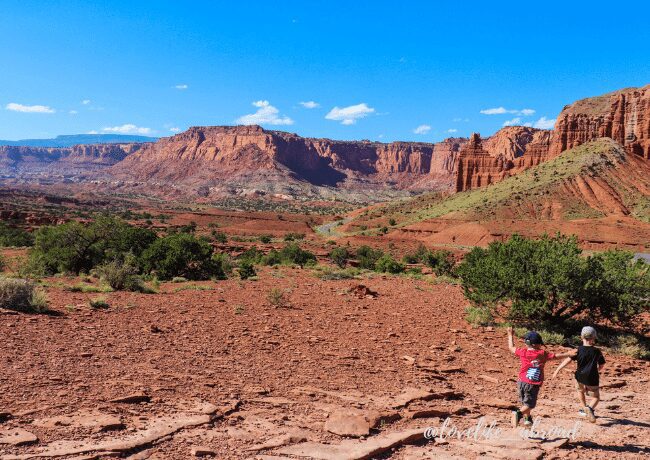
Capitol Reef National Park With Kids
Capitol Reef is the least visited of the Mighty 5, but is a real gem. It is filled with cliffs, canyons, domes, and bridges. And even an orchard offers “Pick Your Own Fruits”. It is a wonderful park to visit with young children.
Capitol Reef National Park Facts
- Elevation: 5,000 feet
- Surface: 378 square miles
- Highest point: 7,041 feet at the Golden Throne mountain
- Visitor: 1.5+ million per year
- Closest town: Torrey
Download our 10-Day Utah National Parks Road Trip Itinerary
The Capitol Reef National Park entrance is 12 miles away from the town of Torrey. Just a few minutes from the Capitol Reef National Park sign is the Goosenecks Point. It’s a great first step into to park to admire the views. There are also short hikes and trail opportunities from the viewpoint.
The park is also famous for its beautiful 16 miles (round-trip) scenic drive to explore its wonders from the comfort of your car. It can be ideal for kids requiring a nap (Car naps are the best when road-tripping). Along the way, there are many stops and viewpoints to get out of the car.
Finally, one of the cool features of Capitol Reef National Park is its orchards in Frutas. The fruit orchards are open to the public so you can pick some fruits to take with you. Isn’t it the perfect hiking snack? Different fruits are available depending on the season, but cherries, apricots, peaches, pears and apples can be found.
Kid-Friendly Hikes in Capitol Reef
Hickman Bridge Trail
There are a few kid-friendly hikes in the park. The Hickman Bridge trail is good, with only a 1.8-mile round trip trail.
Sulphur Creek Waterfall
Otherwise, the Sulphur Creek Waterfall trail is certainly a hit with kids. It’s a 1.8 miles round-trip trail that leads to a swimming hole, and most of the trails follow the river.
Plan extra time on this one to let the kids enjoy the water.
Where to Stay When Visiting Capitol Reef National Park
There is a first-come, first-serve campground in Capitol Reef National Park, located near the orchards. Surprisingly, the campground has a lot of shade, so it’s perfect for hot summer days but fills in quickly.
Your best option for lodging will be in the town of Torrey. There are a few hotels and private campgrounds.
We tried the Wonderland RV park and it was great. The campground has fair-priced campsites with a great location. It is at the corner of the Byway 12 road with easy access to Capitol Reef National Park.
Plus, we got to help feed horses in the morning. It was a precious moment for our boys.
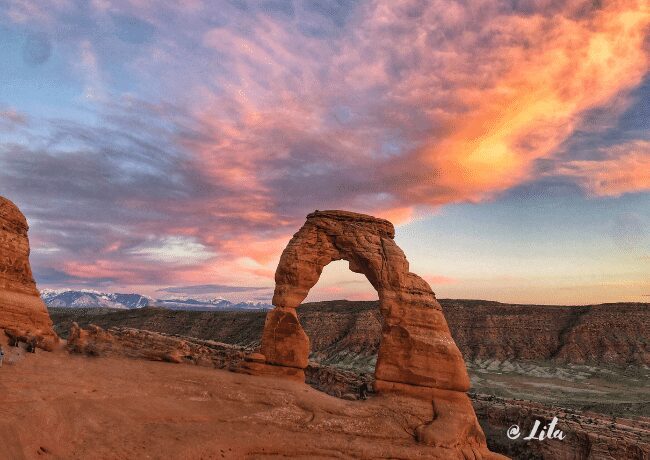
Arches National Park With Kids
This section was curated by Lita Of the Pack.
Arches National Park is in a high desert and contains over 2,000 natural sandstone arches.
Fun Facts of Arches National Park
- Elevation: 4,000 to 5,600 feet
- Surface: 119 square miles
- Highest point: 5,653 feet at Elephant Butte
- Visitor: 1.5+ million per year
- Closest town: Moab
Download our 10-Day Utah National Parks Road Trip Itinerary
Arches National Park is one of the most beautiful parks in the country and one of the most family-friendly. Here, you’ll find gorgeous red rocks and more than 2,000 natural arches throughout its vast landscape. Despite having a wide array of arches, you can see most of the park in 2-3 days. With plenty of short hikes, this is a family-friendly destination.
Family-Friendly Hikes in Arches National Park
Some of the most beautiful arches in the park are found on short walks or easy hikes. Some of the best hikes for people of all ages include the Landscape Arch trail, Double Arch, Broken Arch, and the Windows Primitive Loop. However, the most iconic arch in the park is the Delicate Arch. This trail is a little longer at 3 miles, but it is worth seeing the arch on the Utah license plate.
Where to Stay When Visiting Arches National Park
Moab is an adventurous town and home to Arches and Canyonlands National Park. That means that there are plenty of places to stay and adventures to go on in town. The SpringHill Suites by Marriott Moab and Hyatt Place Moab in Moab are great options if you want to stay in hotels.
However, if you want something more unique look into Moab Springs Ranch or UnderCanvas Moab. These accommodations all have great amenities and ways to entertain your families outside of the park itself.
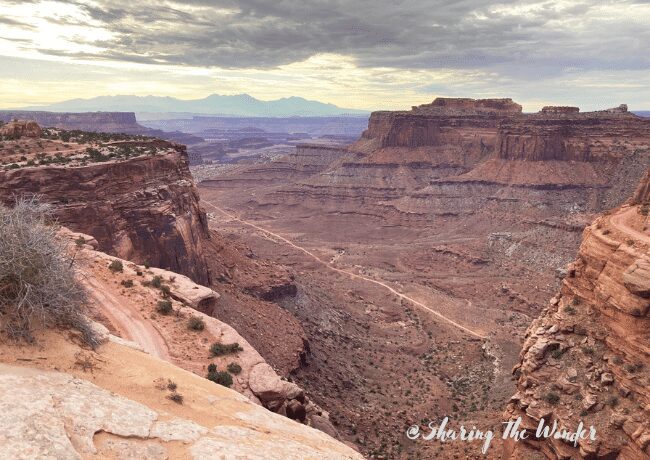
Canyonland National Park With Kids
This section was curated by Sharing The Wander as they visited Canyonlands as part of their Epic Cross-Country Road Trip.
Canyonlands National Park is a very large park, it is divided into five sections, each with its own visitor’s center. You cannot cross between sections within the park, they each have their own entrance.
Canyonlands National Park Fun Facts
- Elevation: 5920 feet
- Surface: 527 square miles
- Highest point: 7,120 feet at Cathedral Point
- Visitor: 0,7+ million per year
- Closest town: Moab
Download our 10-Day Utah National Parks Road Trip Itinerary
The Island in the Sky section of the park is the most kid-friendly, and the easiest to reach from Moab. Plan to spend between half a day and one full day exploring Canyonlands.
When entering the Island in the Sky section of Canyonlands, stop at the visitor’s center just past the entrance. This is a great place to get a map, junior ranger packets, and check in with rangers.
The panoramic views across the road from the visitor’s center are some of the best views in the park. The area is slightly terraced, but it’s a safe area for kids to wander a bit, just don’t let them get too close to the edge.
Family-Friendly Hikes in Canyonland National Park
Grand View Point Trail
The Grand View Point Trail is one of the most popular trails in Canyonlands. This is a mostly flat 2.1 mile out and back trail that follows the canyon edge. There is no barrier between you and the edge of the canyon, so this may be stressful with young children. This is a great trail for older children, or if you carry kids on your back.
Mesa Arch Trail
There are many family-friendly viewpoints in Canyonlands that do not involve too much hiking. The best trail for families is the Mesa Arch trail, a loop of .7 miles. If you’ve just spent a few days exploring Arches National Park, you may be tempted to skip this- please don’t! The view through the arch is one of the highlights of the park.
Where to Stay When Visiting Canyonland National Park
Most families will want to base themselves in Moab, Utah, to combine visits to both Arches and Canyonlands. Moab has lots of hotel options and family-friendly places to eat and shop.
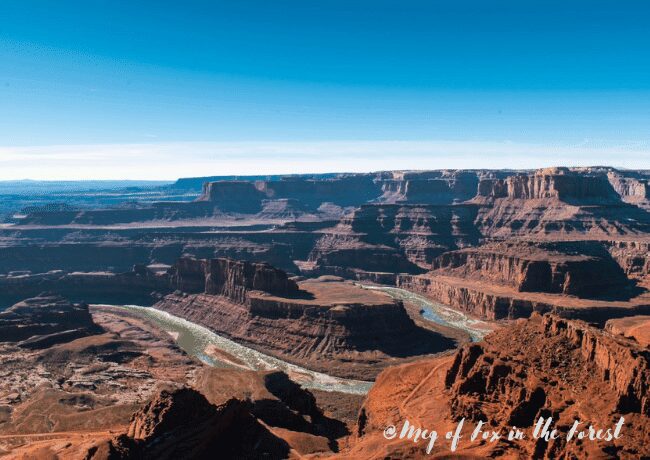
BONUS: Dead Horse Point State Park
This section was curated by Meg of Fox in the Forest
Dead Horse Point State Park is often outshined by its neighbours (Arches and Canyonlands National Parks), but it’s worth visiting if you’re keen to see views just as good, minus the crowds. Not only does Dead Horse Point offer some of the most striking canyon views in the area, but it’s also home to some of the best hikes in Moab.
Plus, most of the hikes here are short and sweet, making them pretty kid-friendly. The West Rim and East Rim hikes are perfect for families wanting to enjoy the desert mellowly. Moreover, there’s also a Junior Ranger Program, where kids can learn more about the wonders of Dead Horse Point via exercises, interpretive talks, and walks from spring to fall.
Where to Stay When Visiting Dead Horse Point State Park
Because at least two days are recommended to fully explore Dead Horse Point, overnighting in the park is a great idea. There aren’t any hotels at Dead Point, but several campgrounds are scattered all over the park, or you can also opt to sleep inside a yurt in the middle of the desert! Not only is camping in the desert a unique experience for the whole family, but Dead Horse Point is listed as a Dark Sky Park, meaning the stargazing here is out of this world!
What to Know When Planning a Utah National Parks Road Trip
Like any road trip, there are a few things to keep in mind when planning a Utah National Parks road trip, especially with kids:
1. The Utah National Parks WILL be crowded
Utah national parks are not called The Mighty 5 for no reason. There are worst visiting, thus can be crowded in high season. It’s not always possible to travel off-season with school-age kids, summer and long holidays may be your only chance to visit. So be prepared for the crowds, especially at Zion National Park.
Here are a few tips to navigate through the crowded national parks:
- Use the parks’ shuttles if possible as parking spots will be limited
- Arrive early morning or late afternoon
- Don’t squeeze too much into your days
- Breathe and enjoy the views
Even with the crowds, all Utah national parks are worth visiting, but keep the crowd in mind with creating your Utah national parks itinerary.
2. All National Parks in Utah are in high altitude
As you may have realized when reading the facts sections for each national park, you’ll be in high elevation for your entire Utah national parks road trip. The average elevation throughout Utah is 6,100 feet (1,860 m). Only Colorado and Wyoming have high average elevation than Utah.
If you are starting your road trip from your hometown, you’ll slowly have time to acclimate to the high altitude and you shouldn’t feel too much the side effect of high elevation. But if you are flying directly to Salt Lake City (4,300 feet elevation) from a low elevation town, it can be a good idea to take it slow the first few days.
At high altitude, you and your family may experience a few symptoms of altitude sickness, such as:
- headache.
- dizziness.
- tiredness.
- loss of appetite.
- shortness of breath.
- swelling
- trouble sleeping
It is important to take the elevation factor when planning your Utah national parks road trip, especially with little children. Even easy hikes can become hard at high elevations, so keep that in mind.
3. Don’t count the distance in miles, but rather in time.
Within the national park’s boundaries, but also from national parks to national parks, the roads are winding and narrow. Don’t create your Utah national parks itinerary based on a cruising speed of 60-70 miles per hour (100-110 km/h), you will fall behind quickly.
And there are so many stops to do along the way, whether it’s a short hike, breathtaking viewpoints, or a cool kids’ playground. You’ll want to leave enough time for the driving part of your Utah national parks road trip, as it’s all about the journey, not only the destination 😉
4. You should invest in a National Park Annual Pass
If you are serious about hitting all of the Mighty 5, you may want to invest in the America is Beautiful pass. There is an entrance fee for each national park (valid for 7 consecutive days within the same national park. Entrance fees vary depending on the national park:
- Zion National Park: 35$
- Bryce National Park: 35$
- Capitol Reef National Park: 20$
- Arches National Park: 30$
- Canyonland National Park: 30$
If paying individually for each national park entrance fee, the total cost comes to 150$, while the America is Beautiful pass costs 80$ for unlimited access to all USA National Parks for an entire year. The choice is pretty easy 😉
When is the Best Time to Visit Utah’s National Parks
All of the Mighty 5 National Parks operate year-round, so can be visited each season. During the summer season, it’s obviously extremely crowded, but also really hot. There isn’t a lot of shade in those national parks.
If visiting in the winter, crowds will be smaller, but it can be really cold (and covered in snow) due to the high elevation of the national parks. Plus, you may experience some closure and limited activities.
Spring and fall are the best seasons to visit the Utah National Parks. It will probably still be crowded, but better than in the summer. The weather will be great, but cooler than in the hot summer months.
Final Thoughts: Best National Parks in Utah for Kids
The 5 Utah National Parks are perfect for families. Zion National Park and Arches National Park are often listed as the best national parks in Utah for kids, but if you have the time, I would highly recommend visiting all 5 national parks.
